#Duke of Newcastle
Explore tagged Tumblr posts
Text
French Chefs Abroad: Clouet to Newcastle, Part I
The Duke of Newcastle’s castle Once upon a time, every duke and lord in the kingdom coveted his neighbor’s French cook (or chef). And no duke showed his ire and disappointment more than did the Duke of Newcastle [Thomas Pelham-Holles, British Secretary of State for 30 years and later Prime Minister] when chef Pierre de St.-Clouet left the duke’s entourage. By way of introduction to this most…
#A Complete System of Cookery#Duke of Newcastle#Elizabeth Robins Pennell#My Cookery Books#Pierre Clouet#Thomas Pelham-Holles#William Verral
0 notes
Text
Britannia pt3: Henry Pelham
'The Soft Man She Made a Shield'
she wanted fire. he brought fog.
henry pelham kissed her with trembling lips, offered her peace and pensions, while she dreamed in cannonfire.
“we can heal,” he whispered, as she sharpened her teeth.
he wrote budgets, not ballads. built coalitions, not kingdoms.
and when she asked for blood, he handed her one of his own veins.
he was a plaster on a bullet wound. she peeled him off the second she bled through.
1 note
·
View note
Text




Happy 35th birthday to Princess Eugenie of York!
Born 23 March 1990, Eugenie Victoria Helena is the younger daughter of Prince Andrew, Duke of York, and Sarah, Duchess of York, and a niece of King Charles Ill. At birth, she was 6th in the line of succession to the British throne and is now 12th.
Born in Portland Hospital, London, Eugenie attended St George's School and Marlborough College before studying at Newcastle University, graduating with a bachelor's degree in English literature and history of art. Eugenie also works privately with a number of charitable organisations, including Children in Crisis and Anti-Slavery International.
The Duke of York's Office at Buckingham Palace announced the engagement of Eugenie and Jack Brooksbank on 22 January 2018. The couple had been dating for seven years, and were engaged on vacation in Nicaragua. In April 2018, the couple moved from St James's Palace and took up residence in Ivy Cottage at Kensington Palace. The wedding took place at St George's Chapel, Windsor Castle, on 12 October 2018.
The Brooksbanks have two sons. The first, August Philip Hawke Brooksbank, was born on 9 February 2021 at the Portland Hospital in London. Eugenie gave birth to a second son, Ernest George Ronnie Brooksbank, on 30 May 2023.
10 notes
·
View notes
Text
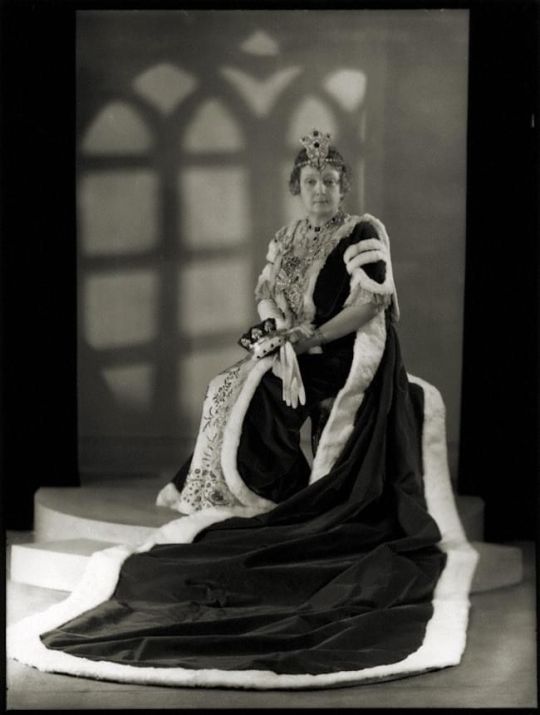
The Most Noble Kathleen Pelham-Clinton, Duchess of Newcastle-under-Lyne, wife of the 7th Duke, in coronation robes, 1937.
9 notes
·
View notes
Text


13th January 1746 saw the Jacobite skirmish at Linlithgow.
Every year this crops up I spend time searching for more info on this event, and every year I end up just using the post as a prelude to the anniversary of The Battle of Falkirk in a few days time.
I did however find a great source with information on Isle of Skye Jacobites captured during the '45 it probably isn't good reading for many of you out there, but I can scour through the lists of names and pick out some interesting data, like Archibald MacLean.
Archie was captured on January 13th at Linlithgow, so must have been involved in the skirmish. He was imprisoned at Leith 20 January 1746, Edinburgh 7 February 1746 then at Carlisle 8 August 1746. Nothing more known of him so may have died as he does not appear on transportation lists.
Another Archie, just screams to me the archetypical Highland Scot from days gone by to me.
Archibald MacPherson was only 16 and only 4' 9" small, he is described as thick and pock pitted. He was captured at the surrender of Carlisle on 30 December 1745 and imprisoned at Carlisle, York Castle and Lincoln Castle. Transported to Antigua, 8 May 1747. On list of prisoners aboard the ‘Veteran’. ‘Veteran’ was captured near Antigua, 28 June 1747 by the 'Diamond' a Privateer and carried into Martinique on 30 June 1747. All prisoners aboard were released, I wonder what happened to the wee man.....
There were also many women among the prisoners, another Isle of Skye Jacobite was Ann MacKay. She was in Inverness in the house in which Robert Nairn and MacDonald of Belfinlay were put after they were brought in wounded from Culloden. She assisted in a plot laid by certain ladies to help Nairn escape. She was captured and imprisoned in Inverness Tolbooth and sentenced to be whipped through the town; but this was prevented through interest brought to bear on the military authorities. She was, however, for some time not
allowed to sit or lie down, in order to get her to confess the names of her associates. This she refused to do. After
some weeks she was released.
A number of clergy were also arrested during the Uprising, one was Rev. Alexander S. J. Cameron, from Strathglass
Regiment: Cameron of Lochiel's his prisoner record read
Rank: Chaplain
Prisoner no.: 313
Third son of John of Lochiel and brother of Cameron of Lochiel of the ‘45. He was a Jesuit Priest. It is not known what
part he took in the 1745 Rebellion.Taken prisoner at Morar, July 1746 and put on board HMS ‘Furnace’ where Captain Ferguson was ships Captain. He was not allowed a bed to lie on, except ships cables. He fell ill and Lord Albemarle ordered him to be put ashore. Ferguson refused to give him up without an order from the Duke of Newcastle. He also refused to allow any bedding or clothes to be supplied to him. Cameron died soon after HMS ‘Furnace’ arrived in the Thames.
Often when I am reading things like this it leads me to other information and before I know it I have several pages open going from one to the other gathering my information for posts, on this occasion I discovered a wee bit more on the Furnace and her Captain.....
Flora MacDonald had also been aboard the Furnace, the captain of the ship is said to have been known for his abuse of prisoners. One incident illustrating Ferguson's character was reported by Felix O'Neill a Jacobite captain in the Prince's service who had been captured shortly before Flora,
'I was … brought before Captain Ferguson, who used me with the barbarity of a pirate, stripped me, and had ordered me to be put in a rack, and whipped by his hangman, because I would not confess where I thought the Prince was. As I was just going to be whipped, being already stripped, Lieutenant McGaghan of the Scots Fusiliers, who commanded a party under Captain Ferguson, very generously opposed this barbarous usage, and coming out with drawn sword, threatened Captain Ferguson that he would sacrifice himself and his detachment rather than see an officer used after such an infamous manner'.
During his search for Bonnie Prince Charlie, Ferguson had seized an instrument of torture known as 'the Barisdale' after MacDonald of Barisdale its inventor. Despite the belief, widely held even today, that no-one in the Highlands and Islands would give any information to the authorities about Prince Charles’ movements, fairly soon after Flora's and the Prince’s journey to Skye, the authorities knew all about it. About the 6th of July Ferguson captured one Lachlan MacMhurrich in Benbecula, who 'Being immediately put into Barisdale, confessed that the Younge Pretender left South Uist Satturday the 28th of last month. That he was gone to Trotness [Trotternish] a place in Skye.' Several other prisoners were also taken and made to confess, so that within two weeks of arriving in Skye her part in the escape was known and she was arrested.
Although Flora was to be imprisoned aboard Ferguson's ship, the Furnace, General John Campbell of Mamore, the officer in charge of the search for the Prince, ordered that Flora 'be used with the utmost respect'. It was to Campbell that Flora told her story in Applecross Bay on the 12th of July 1746.
The pic shows a list of Jacobite slaves exported to the West Indies. Note that many on this list are from East & N.E. Scotland and England. Most of the Highlanders appear to be Roman Catholics from Inverness Shire. Most of them would be Catholics and Episcopalians.
This was flagged up on one of the sites I use regularly but I can find no more about the "Skirmish, I did however find a great source with information on Isle of Skye Jacobites captured during the '45 it probably isn't good reading for many of you out there, but I can scour through the lists of names and pick out some interesting data, like Archibald MacLean.
Archie was captured on January 13th at Linlithgow, so must have been involved in the skirmish. He was imprisoned at Leith 20 January 1746, Edinburgh 7 February 1746 then at Carlisle 8 August 1746. Nothing more known of him so may have died as he does not appear on transportation lists.
Another Archie, just screams to me the archetypical Highland Scot from days gone by to me.
Archibald MacPherson was only 16 and only 4' 9" small, he is described as thick and pock pitted. He was captured at the surrender of Carlisle on 30 December 1745 and imprisoned at Carlisle, York Castle and Lincoln Castle. Transported to Antigua, 8 May 1747. On list of prisoners aboard the ‘Veteran’. ‘Veteran’ was captured near Antigua, 28 June 1747 by the 'Diamond' a Privateer and carried into Martinique on 30 June 1747. All prisoners aboard were released, I wonder what happened to the wee man.....
There were also many women among the prisoners, another Isle of Skye Jacobite was Ann MacKay. She was in Inverness in the house in which Robert Nairn and MacDonald of Belfinlay were put after they were brought in wounded from Culloden. She assisted in a plot laid by certain ladies to help Nairn escape. She was captured and imprisoned in Inverness Tolbooth and sentenced to be whipped through the town; but this was prevented through interest brought to bear on the military authorities. She was, however, for some time not
allowed to sit or lie down, in order to get her to confess the names of her associates. This she refused to do. After
some weeks she was released.
A number of clergy were also arrested during the Uprising, one was Rev. Alexander S. J. Cameron, from Strathglass
Regiment: Cameron of Lochiel's his prisoner record read
Rank: Chaplain
Prisoner no.: 313
Third son of John of Lochiel and brother of Cameron of Lochiel of the ‘45. He was a Jesuit Priest. It is not known what
part he took in the 1745 Rebellion.Taken prisoner at Morar, July 1746 and put on board HMS ‘Furnace’ where Captain Ferguson was ships Captain. He was not allowed a bed to lie on, except ships cables. He fell ill and Lord Albemarle ordered him to be put ashore. Ferguson refused to give him up without an order from the Duke of Newcastle. He also refused to allow any bedding or clothes to be supplied to him. Cameron died soon after HMS ‘Furnace’ arrived in the Thames.
Often when I am reading things like this it leads me to other information and before I know it I have several pages open going from one to the other gathering my information for posts, on this occasion I discovered a wee bit more on the Furnace and her Captain.....
Flora MacDonald had also been aboard the Furnace, the captain of the ship is said to have been known for his abuse of prisoners. One incident illustrating Ferguson's character was reported by Felix O'Neill a Jacobite captain in the Prince's service who had been captured shortly before Flora,
'I was … brought before Captain Ferguson, who used me with the barbarity of a pirate, stripped me, and had ordered me to be put in a rack, and whipped by his hangman, because I would not confess where I thought the Prince was. As I was just going to be whipped, being already stripped, Lieutenant McGaghan of the Scots Fusiliers, who commanded a party under Captain Ferguson, very generously opposed this barbarous usage, and coming out with drawn sword, threatened Captain Ferguson that he would sacrifice himself and his detachment rather than see an officer used after such an infamous manner'.
During his search for Bonnie Prince Charlie, Ferguson had seized an instrument of torture known as 'the Barisdale' after MacDonald of Barisdale its inventor. Despite the belief, widely held even today, that no-one in the Highlands and Islands would give any information to the authorities about Prince Charles’ movements, fairly soon after Flora's and the Prince’s journey to Skye, the authorities knew all about it. About the 6th of July Ferguson captured one Lachlan MacMhurrich in Benbecula, who 'Being immediately put into Barisdale, confessed that the Younge Pretender left South Uist Satturday the 28th of last month. That he was gone to Trotness [Trotternish] a place in Skye.' Several other prisoners were also taken and made to confess, so that within two weeks of arriving in Skye her part in the escape was known and she was arrested.
Although Flora was to be imprisoned aboard Ferguson's ship, the Furnace, General John Campbell of Mamore, the officer in charge of the search for the Prince, ordered that Flora 'be used with the utmost respect'. It was to Campbell that Flora told her story in Applecross Bay on the 12th of July 1746.
The pic shows a list of Jacobite slaves exported to the West Indies. Note that many on this list are from East & N.E. Scotland and England. Most of the Highlanders appear to be Roman Catholics from Inverness Shire. Most of them would be Catholics and Episcopalians.
14 notes
·
View notes
Note
I am extremely interested in your draft/post about Downton Abbey and the timeline 👀
Important disclaimer: I was never in the fandom of the series, so I'm completely ignorant as to word of god and fanon, and might have forgotten some details of the plot as the years have passed since I watched.
*video essay voice* (bear with me) in 1980, British playwright Peter Flannery, while watching rehearsals for Henry IV, felt inspired to write his own historical epic, a Shakespearean sort of short History of his native Newcastle from the 60s to the present, interweaving the personal History of 4 "friends" with the big historical events of Britain through those years, to create a strong political narrative through them, but that was life-like enough in its everyday life details and turns as to feel real. The characters deal with their desire to change the world, achieve success, recognition, or even just survive, and experience hope and hopelessness by turns*
This theater play, called Our Friends in the North, caught the eye of the BBC, and after several back-and-forths it was adapted into 9 episodes in 1996. It was a big bet (it cost 8 million pounds to produce) and a big hit, and I do get the gut feeling that in some corner, the first season of Downton is inspired in OFITN as a concept, a sort of Our Freenemies in Yorkshire, but that its own success derailed it into a different direction, and made it Edwardian-Roaring 20s Aristofairytaleland, the same way Regency Romance tends to take place on a Regency Fairytale land full of dukes and none of the social, economical and political problems of the time.
S1 of DA hinges around the "Death of the old world" theme: it opens with its first marker (the sinking of the Titanic) and closes with the last marker (the beginning of the Great War). The central plot is that of the survival of Downton as a place and an institution -the kickstart is the death of James and Patrick aboard the Titanic, and the next heir presumptive being a middle class lawyer, an outsider to the aristocracy. The old, dying aristocracy, managed to patch up their situation by marrying rich American heiresses, like Cora, but it doesn't have any vitality for the future: the heir (Robert and Cora's son) is born dead. The question then is "can the aristocracy make a bridge with the raising professional middle class, merge with it in order to gain new life?" that's what Matthew's plotline this season is all about, specially in his growing and changing relationship with Robert and Mary (who are the epitome representatives of the aristocracy, with lady Violet): there is a small seed of aspiration that grows through the season, but gets quashed once he realizes that as much as he has grown to care for the Crowleys, they haven't really grown to care for him as anything but an uncomfortable necessity. And so he leaves. And the Great War begins. No compromise can be reached, the old world is dead.
I don't think I say anything controversial when I say that Fellowes and Downton as a series loves Mary with undying devotion; she gets a second chance at Matthew in s2 that she wouldn't have gotten IRL, and she would have kept Matthew forever if the actor didn't want out. And I think Dan Stevens wanting out (and Jessica Brown's to a certain extent), and as much as he can say within the bounds of politeness, has a lot to do with a sense that the series he signed up for was not the series he ended up being in on the follow up seasons. Matthew, who was a central character to the main plot of the series in s1, now gravitates Mary's storylines, because that pressing conflict of the inheritance is solved, and he can be disposed of as soon as he produces a male heir without causing any plot-ripples. A story about Downton the house as anchoring to class conflicts and point of connection with big events becomes a story of Mary and her relatives with Downton as a mainly aesthetic backdrop as s2 progresses (yes, yes, every once in a while some lip service is given to "money troubles" and having to downsize, but it's just... that).
As seasons progress, as well, the historical markers to open and close a season disappear, and so do... general historical events at all. The story gets atomized and more and more separated from History, and "the old world is dying" theme vanishes.
So, now, on this premise (that Downton S1 and Downton s2-6 are different animals, with different core themes and structures) where do I think a true continuation of S1 would have gone?
Mind you, I haven't plotted five series to detail, because I'm not that invested. But also it feels like DA the series itself started running out of plot after s4 anyways, so, in general lines:
The same way OFITN did (episodes were each set on a different year: 64, 66, 67, 70, 74, 79, 84, 87, 95) every series would have a time skip that would tie in with bigger scale events in Britain and the world (the end of the Great War, the Spanish Flu, the crack of 29', etc), and in my mind I would have it cover until the late 1940s: the series begins with a middle aged Robert and Cora, and ends with a middle-aged next generation.
Matthew does actually marry Lavinia, and takes William with him as they bonded in the war, and goes back to his job. They try to keep their distance from Downton, but, of course they keep getting drawn in because of the inheritance.
Matthew's marriage to Lavinia means a vital wake-up call for Mary: she -and by extension the aristocracy- cannot always get what she wants, even though her name and status carry a lot of importance. But she also experiences new freedom because her choice of husband has now no influence on the fate of the estate. I think she'd choose to travel a lot, in ways that would widen her mental horizons and change her feelings and perspective about her family. I even feel like her marrying Henry Talbot in the end makes sense; she remains ever the aristocrat (although I'd think she'd marry later, probably past her mid-30s, a spirit of the new times).
Sybil's storyline remains the same, minus death (in this scheme, the core characters that thread the timeline are the Crawley sisters AND Matthew), but she never returns to Downton to stay, and it is through her and her visits that we do get the perspectives and storylines of the process of independence for Ireland, and her complicated position as wife of an Irish man but daughter of a British earl. You can even get stories in the later years storylines like Marygold trying to run to Ireland and her aunt after WWII breaks.
A similar thing goes for Edith; if Mary is and makes the choice of aristocracy, and Sybil makes the choice of a working class life, then Edith embodies a commercial-professional upper middle class aspiration (in fact, I do think that her punching-bag status in the series has a lot to do with Fellowes derision of that class), so it makes sense for her to do most of the things she does towards her place in life; just cut some of the drama and no sudden marquess nonsense in the end. Edith and Bertie marry and remain successful editors/printers/periodical owners.
As for the house itself, of course Matthew inherits (you could set Robert's death for 1929, and then have a Lavinia inheritance save the estate after Robert's failed investments like it goes in s1). I do think this lends itself to interesting dynamics, specially with the servants, considering the aristocratic head is gone and the Great War significantly changed the self-image of the serving class, plus the return of William now in a much more privileged place; but also with Cora as the new Dowager and Lavinia as the new Lady Grantham. How do the children adapt to their new home and status? How did their parents conduct their upbringing? I think you can do a lot there (I'd assume just two children, a boy and a girl).
I do also think it'd be interesting to contrast the rising tensions in the 30s as Mary perceives them through her continental travels -I can imagine Henry Talbot joining the foreign service and getting at least obliquely involved in spy shenanigans- and Edith through her very localized work.
The Kingsmen movies play with this idea of WWI creating a generation of fathers who buried their sons and had to take their places. The Crawleys escape this by having only daughters, so I think it is fitting for Matthew and Lavinia's son to die in WWII, and for the daughter to become a war bride and move to the US, as the centre of power moves from the UK to the US.
Downton, more and more difficult to maintain as the years pass, cannot survive the economic blow of WWII, and Mathew and Lavinia, now middle aged, don't have the energy and vitality to begin again; and so they make an arrangement with the just-founded National Trust after the war ends: the main part of the house becomes a museum, but they still get a part of it to live in. I think, after a family reunion tea/party to wrap things up, you can have as a symbolic last shot, a close up of Matthew's hand as he turns over the keys to the Downton gates to the National Trust agent, CUT TO BLACK AND THE DOWNTON ABBEY THEME.
So, hm, that's pretty much it. Please do not maul me to death XD
*While I think the series was very well written, I'd hesitate to recommend it here as there was too much explicit nudity and sexual content for my taste and that of many people here. The 2022 radio adaptation seems to be faithful to the original tv series and avoid that problem, but of course you lose on the other visuals that are quite impressive (and believe me, besides some awkward wigs and make up, they really did blow up that 8 million pound budget in many ways).
67 notes
·
View notes
Photo

Henry Clinton
Sir Henry Clinton (l. c. 1730-1795) was a British military officer who served as commander-in-chief of the British Army in the later stages of the American Revolutionary War (1775-1783). Having arrived in Boston in May 1775, he served in North America for most of the war, resigning his post in 1782 after the British defeat at the Siege of Yorktown.
The son of a British admiral, Clinton became a soldier at the age of 15 and saw action in Germany during the Seven Years' War. Thanks to his connections to British lords, he quickly rose through the ranks and was one of three British generals sent to Boston, Massachusetts, in 1775 to crush the American rebellion. Clinton was famously jealous, paranoid, and quick-tempered, traits that made it difficult for him to work with his fellow officers; still, he was well-educated in military matters and was among the most competent British tacticians of the war. As commander-in-chief, he led the British army at the Battle of Monmouth and the Siege of Charleston, but his lack of support for his second-in-command, Lord Charles Cornwallis, contributed to the British loss of the American South. After the war, he returned to England, where he received much of the blame for the British defeat before his death in December 1795.
Early Career
Little is known about Clinton's early life or childhood. He was likely born on 16 April 1730, although the time and location of his birth have been disputed; some scholars claim he was born in Newfoundland when his father was governor there, which, if true, would push his birth year back to 1732 at the earliest. What is known for certain, however, is that he came from a wealthy family of noble pedigree. His family was a cadet branch of the House of Lincoln, which could trace its earldom back to the reign of Elizabeth I of England (r. 1558-1603), and his uncle was related by marriage to the first Duke of Newcastle, who often lent his patronage to the Clinton family (Willcox, 4). Henry's father was British Admiral George Clinton (not to be confused with the future U.S. Vice President of the same name) and his mother was Anne Carle, a general's daughter. He also had two siblings, both sisters, who survived to adulthood.
Through the Duke of Newcastle's influence, Admiral Clinton was appointed governor of the Province of New York in 1741. The admiral did not arrive to take up his post until September 1743, taking his family with him. Henry, who was at most 13 when he arrived in New York, was probably educated at the Long Island school of Samuel Seabury, the future first bishop of the American Episcopal Church. In 1745, he began his military career when he enlisted in the New York militia as a lieutenant. The following year, his father procured for him a captain's commission, and he was sent to join the garrison of Louisbourg, a fort on the Saint Lawrence River that had recently been captured from the French. While stationed there, he was ambushed by a band of French and Native Americans, narrowly avoiding death by "stripping and jumping into the sea" (Willcox, 10).
In the summer of 1749, Clinton realized his prospects for military advancement in the colonies were limited, prompting him to return to England. With Newcastle's help, he was commissioned as a captain in the illustrious Coldstream Guards and, by 1758, he had risen to the rank of lieutenant colonel in the Grenadier Guards. By then, Europe was engulfed in the Seven Years' War (1756-1763) and Clinton's regiment was sent to Germany to bolster the Anglo-German army trying to prevent a French invasion of Hanover. He fought at the Battle of Villinghausen (16 July 1761) and Battle of Wilhelmsthal (24 July 1762), serving shoulder to shoulder with fellow British officers William Phillips and Lord Charles Cornwallis, both of whom would also become prominent generals in the American Revolution. He served as aide-de-camp to Charles William Ferdinand, future Duke of Brunswick, (the same Prussian general who would one day fight the French revolutionaries at the Battle of Valmy) in whose service Clinton was seriously wounded at Nauheim (30 August 1762).
Continue reading...
16 notes
·
View notes
Text
VBPS (Daphne’s Wedding)
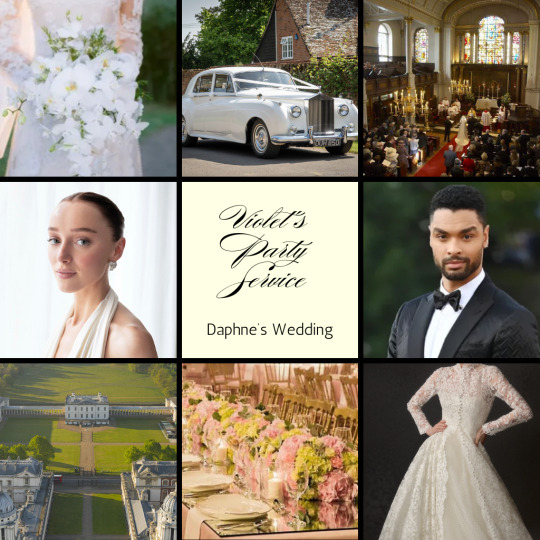
Rated: G Staring: All of the Bridgertons + partners Party #1: Daphne and Simon’s Wedding (2011)
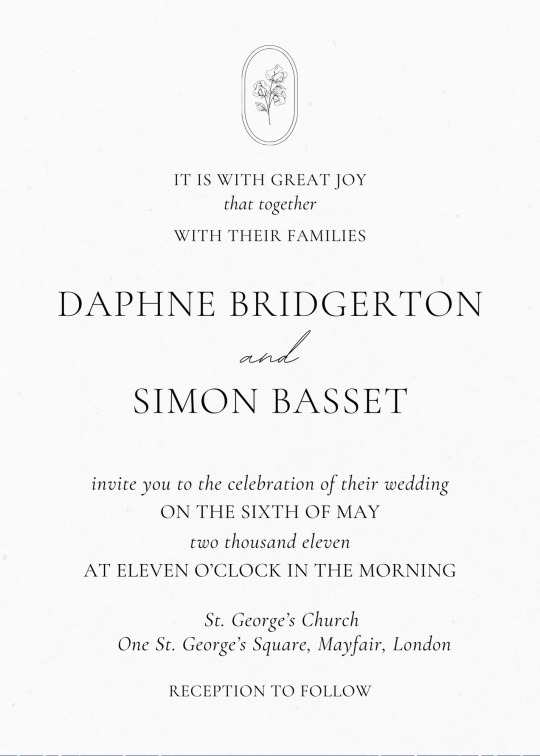
Daphne Bridgerton woke up with a start, her heart fluttering in excitement. It was her wedding day, a day she had dreamed about for as long as she could remember. After a whirlwind romance and over a year of courtship, she was finally marrying Simon Basset, the Duke of Hastings. Her brother Anthony had been reluctant at first—Simon was his best friend, after all—but Daphne’s persistence had worn him down. And now, today, they would all stand together as Simon and Daphne became husband and wife.
As sunlight filtered through her curtains, she couldn’t help but smile. The whole of England’s high society would be in attendance, from commoners to dukes. The only notable absence would be the royals themselves, but honestly, who cared? Prince William’s wedding had been the previous weekend, and she couldn’t exactly compete with that. Not that it mattered. She wasn’t marrying for spectacle; she was marrying for love.
And love was what she felt as she rushed out of her bed and into the hallway. She sprinted down to Eloise and Francesca’s shared room, flinging the door open and letting out a delighted scream.
“IT’S MY WEDDING DAY!” she yelled, practically vibrating with excitement.
“Daphne, for heaven’s sake, it's barely morning.” Eloise groaned, pulling a pillow over her head.
“Argh!” Francesca merely stirred, blinking up at the ceiling. “An hour more,” she mumbled, before turning over to try to steal a bit more sleep. Both of them had just returned from their respective schools—Eloise from Newcastle, where she had taken her final exams, and Francesca from the Royal Conservatoire in Scotland, exhausted from weeks of preparation.
“I’m getting married! Can you believe it?” Undeterred, Daphne twirled around the room.
Eloise groaned again, muttering something unintelligible, but Daphne was already halfway out the door. She decided to channel her energy elsewhere and made a beeline for her youngest sister, Hyacinth’s room. Hyacinth was, at the very least, a little more receptive to her excitement. Daphne burst in and bounced on the bed.
“Hyacinth! I’m getting married today!” she practically sang.
“I know, Daph.” Hyacinth, ever the supportive little sister, grinned sleepily. “You��ve only mentioned it a thousand times.”
“Only a thousand? I should be saying it at least a million times! It’s the best day of my life!” Daphne exclaimed, giving Hyacinth a playful shake before leaping off the bed again to continue her whirlwind morning.
Meanwhile, in the downstairs parlor, Violet was a picture of calm, though inside she was anything but. Being both the mother of the bride and the de facto wedding coordinator had proven to be more of a task than she had imagined. After all, Daphne had left most of the planning to her, trusting her mother’s impeccable taste to handle all the details. Violet had arranged everything perfectly: the grand ceremony, followed by an elegant luncheon and dancing at the Royal Museum in Greenwich.
It was going to be beautiful—if everything stayed on schedule.
She sighed as she arranged the final seating chart, the sound of Daphne’s exuberant declarations echoing through the house.
"It's her wedding day," she murmured with a smile, shaking her head.
Violet had seen all her children grow up so quickly, but this felt like a new chapter for Daphne. She hoped her daughter would find as much joy in her marriage as she had in planning this special day for her.
“Mother!” Daphne burst into the room, her cheeks flushed with excitement. “Is everything ready?”
Violet nodded calmly, though she felt a twinge of stress.
“Yes, my dear. The venue is set, the guests are confirmed, and the flowers are being delivered as we speak.”
“And Simon?” Daphne’s eyes sparkled.
“Simon is already preparing at his townhouse.” Violet smiled, remembering how in love her daughter was with the dashing duke. “You’ll see him at the ceremony.”
“I can’t believe it.” Daphne clasped her hands to her chest, practically floating. “I’m actually going to be his wife. After all the years of dreaming about a wedding, it’s actually happening!”
“You deserve all the happiness in the world, darling.” Violet stood and smoothed her daughter’s hair. “Today is your day.”
Daphne smiled, her heart full, as she let her mother’s words sink in. Today was indeed her day, but it wasn’t just about the grand event or the famous guests or even the beautiful gown. It was about her future with Simon—the man she loved, the man she’d convinced her family to embrace. And in a few short hours, she would walk down the aisle to him, sealing their love in front of everyone who mattered.
As she turned to leave, Daphne called out one last time to anyone within earshot:
“It’s my wedding day!”
And despite the laughter, groans, and eye-rolls she received in return, everyone who loved her couldn’t help but smile too. Because today was, without a doubt, Daphne’s day.
Read more on AO3
#bridgerton fanfiction#violet bridgerton#saphne#simon x daphne#simon basset#daphne bridgerton#anthony bridgerton#benedict bridgerton#colin bridgerton#eloise bridgerton#francesa bridgerton#gregory bridgerton#hyacinth bridgerton#penelope featheringon#saphne fanfic#bridgerton
10 notes
·
View notes
Text
Me: Alright you chuckleheads, this may be a pleasure trip but give me some locations so I can get research done too.
Sebastian: If it’s not too much trouble, Leavenworth?
Dimitri: You’re already going to UW, so the Woodmark Hotel for next season’s finale?
Luna: Newcastle Beach Park for the Season 3 opener!
Jasmine: The Dennys across from the airport for Season 4.
Duke: Alaska.
Me: That’s not within the state of Washington, Duke.
3 notes
·
View notes
Text
The Duke of Newcastle's Pique, or, A Good Chef is Hard to Find
The Duke of Newcastle and His Cook (British Museum Print no. 2684) The diarist Samuel Pepys, no mean observer of human foibles that relieve the monotony of day-to-day human life, recorded — almost in real-time — the Francophilic transformation of the English nobility after the 1660 Restoration of the Stuart monarchy. Since Pepys devoted a portion of his library to cookery, it’s not surprising…
#Cuisine Francaise#Duke of Newcastle#Earl of Albemarle#France#French cuisine#London#Pierre St.-Clouet#Samuel Pepys#Tammany Hall#Thomas Pelham-Holles 1st Duke of Newcastle#William Keppel
0 notes
Text
From Downing Street in March 1862, His Grace delivered a mighty rebuke:
The first lesson of importance which a savage ought to learn from a civilized Government is the difference between discriminating justice and indiscriminate vengeance. This lesson some of the most degraded Indians of North America have learnt from the Hudsons Bay company, and the consequence is that persons connected with that Company can travel with safety when a Known native* of the United States would be murdered, if possible, by any Indian who met him. I do not know why the Australians should be incapable of learning this lesson and I hope the Government of Queensland is not incapable of teaching it. When this is done and not till then I shall entertain some hope that the Colony under your Government may be an exception to that unhappy law which seems to prohibit the occupation of the same country by the Anglo Saxon and the Aboriginal.
* Citizen.
"Killing for Country: A Family History" - David Marr
#book quotes#killing for country#david marr#nonfiction#downing street#march#60s#1860s#19th century#duke of newcastle#rebuke#native american#united states#north america#indigenous australians#aboriginal australian#qld#queensland#australia#anglo saxon#colonization
0 notes
Text
✨ 15 days of Princess Anne ✨
August is Princess Anne’s birth month and her 73rd birthday is on the 15th so until then we will look at her fascinating life, one photo for every year!
The sixties
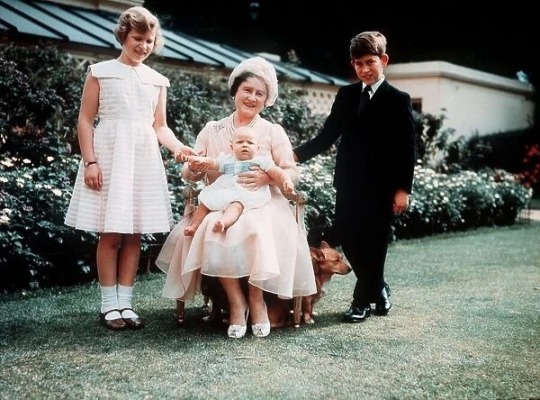
1960 Queen Elizabeth, The Queen Mother with her three grandchildren, Princess Anne, Prince Charles and newborn Prince Andrew, August 1960.
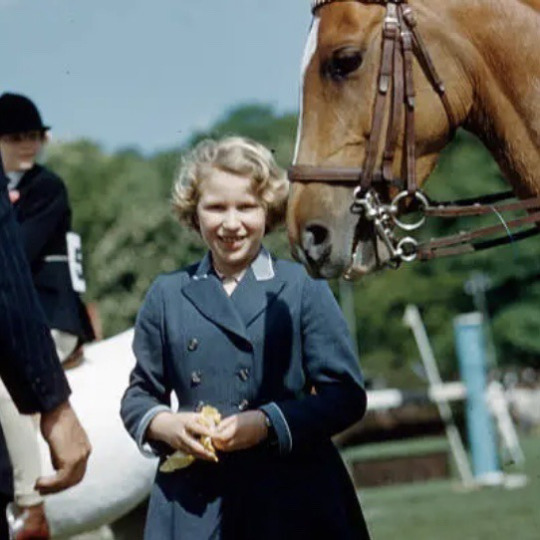
1961 Princess Anne at the Royal Windsor Horse Show in Berkshire on 13th May 1961.
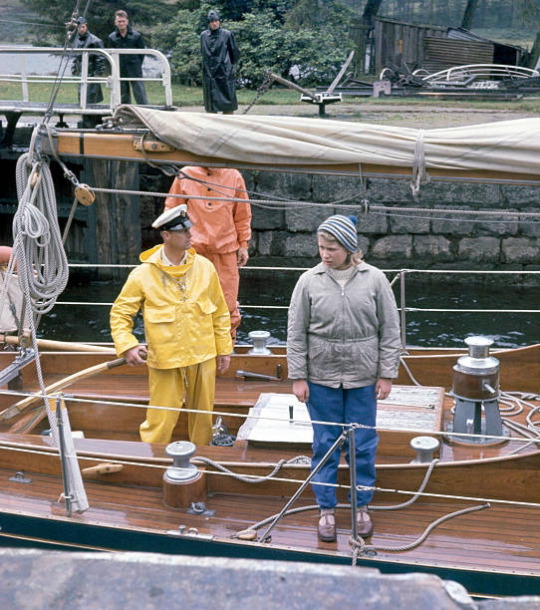
1962 Prince Philip at the helm (in yellow sou'wester) with his daughter Princess Anne on board the Royal Yawl "Bloodhound" during a sailing holiday on Loch Oich, Invernesshire on 23rd August 1962.
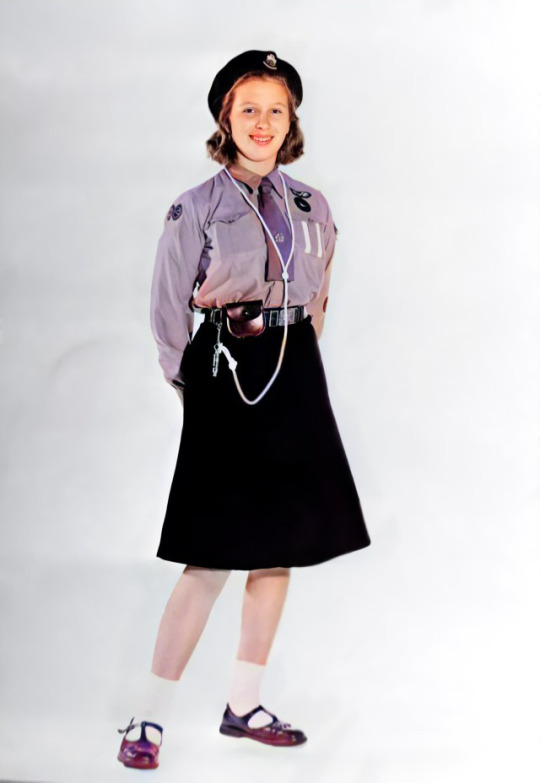
1963 A portrait of Princess Anne wearing a girl guides uniform taken for her 13th birthday on 9th August 1963
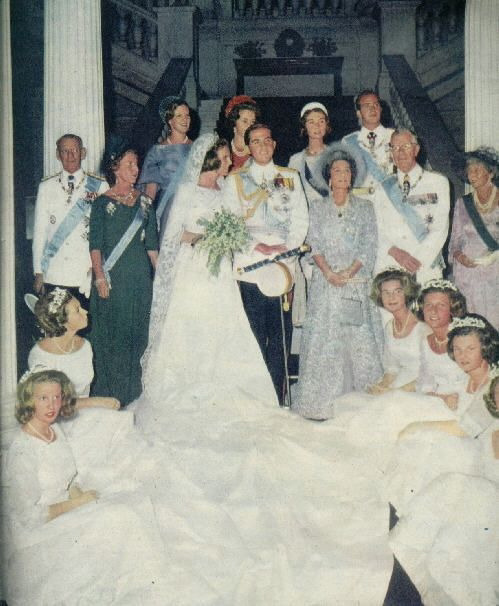
1964 Princess Anne (bottom left) as a bridesmaid at King Constantine & Queen Anne-Marie’s wedding on 18th September 1964.
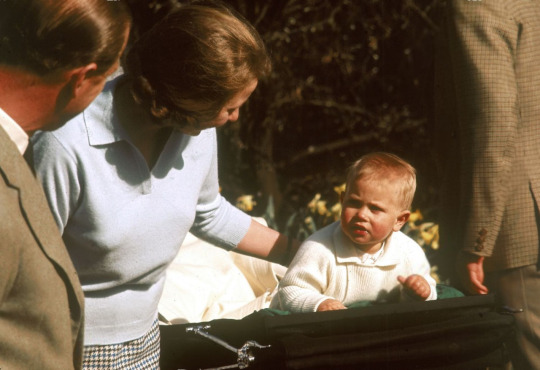
1965 One year old Prince Edward in his pram with his elder sister Princess Anne and their father Prince Philip which was taken at Frogmore on 13th April 1965.
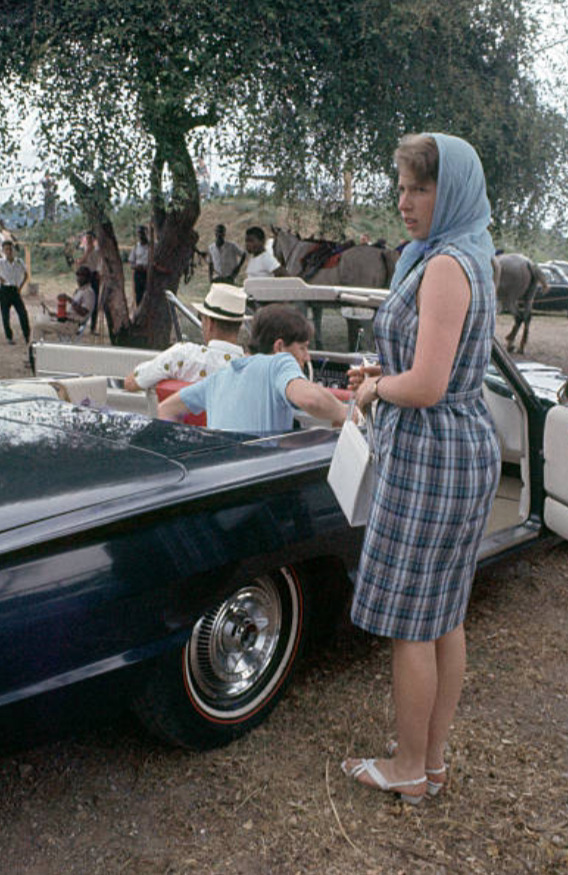
1966 Princess Anne with Prince Charles and Prince Philip, behind the wheel arriving at a polo match in Kingston, Jamaica on 10th August 1966.
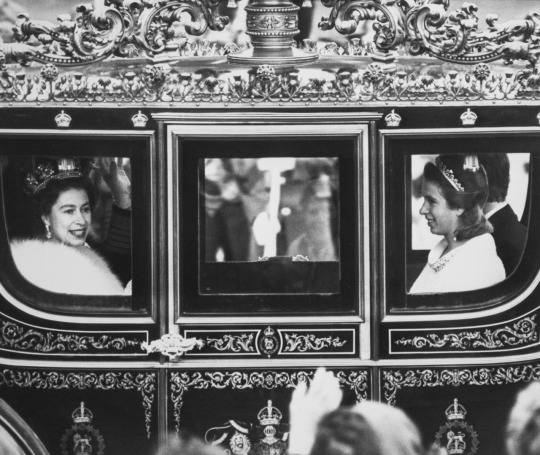
1967 Princess Anne’s first tiara appearance (the Cartier Halo tiara), at the 1967 state opening. She is travelling in a state coach with her mother, Queen Elizabeth II, her father, The Duke of Edinburgh and her brother, Prince Charles to the Houses of Parliament.
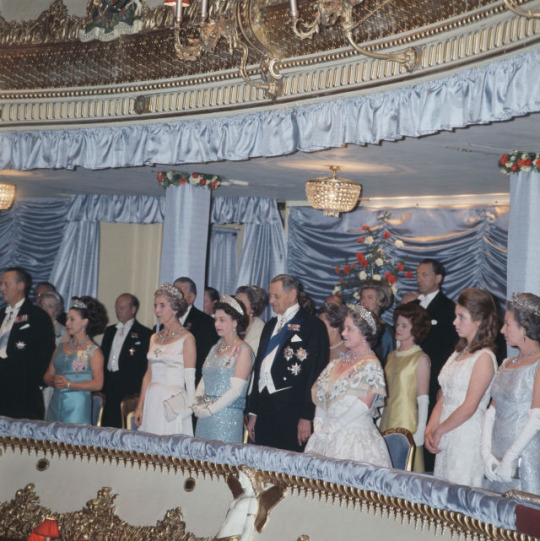
1968 Princess Anne (front, second from left) with members of the Danish and British royal families in the royal box at the Royal Opera House in Covent Garden, London, UK, 29th April 1968. From left to right, Prince George of Denmark, Princess Margaret, Queen Ingrid of Denmark, Queen Elizabeth II, King Frederick IX, Queen Elizabeth The Queen Mother and Princess Anne of Denmark.

1969 Princess Anne at her first ever engagement where she launched Esso Northumbria in Newcastle on 02/05/1969
(50’s)
67 notes
·
View notes
Text
MARGARET CAVENDISH
MARGARET CAVENDISH, DUCHESS OF NEWCASTLE-UPON-TYNE
1623 – 16 December 1673
Margaret Cavendish, ‘Mad Madge’, was known for her eccentric lively personality. Samuel Pepys described her outfits as ‘mad, conceited and ridiculous.’ She wanted to be unique and disliked wearing the same fashions as other women.
Her parents were Thomas Lucas and Elizabeth Leighton and she was married to Marquess (Duke) William Cavendish who she called ‘Peg’. She actively ran her husband’s lands, including Bolsover Castle. She wrote that her husband would go out of his way to dress fashionably and described him as ‘neat and cleanly, which makes him to be somewhat long in dressing.’ He was a Royalist commander during the first English Civil War soldiers who served with him during the Civil War said that he ‘lay in bed until eleven o’clock and combed till twelve.’ Margaret worked as an attendant to Queen Henrietta Maria and was with her in exile in France and lived at the court of King Louis XIV. They returned to England when the Stuart Restoration took place in 1660. She and her husband remained childless, despite wanting children.
Margaret is best known for publishing several books under her own name, including, ‘Opinions, Observations and Orations’ which she wrote about political and natural philosophy, gender studies and religion. She was the most published female writer in the 17th century, she also wrote plays, criticisms, and poetry.
Margaret was an animal lover, who was one of the first to oppose testing on animals. She used her fame to advocate women’s education and was disappointed she couldn’t attend school like her brothers could. She died aged 50 in London in 1674 and was buried in Westminster Abbey.

#margaretcavendishduchessofnewcastleupontyne #margaretcavendish
3 notes
·
View notes
Text
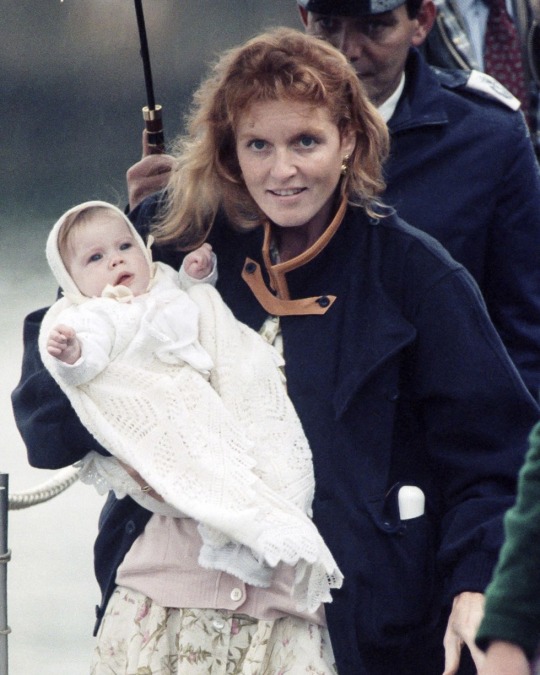


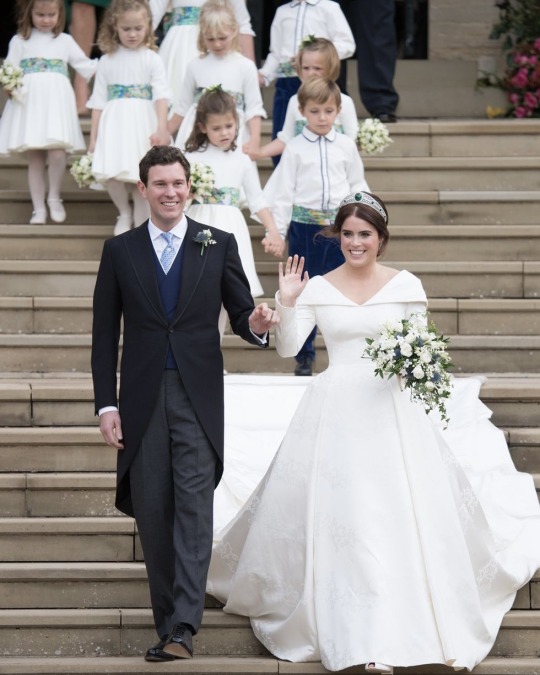
Happy 34th birthday to Princess Eugenie of York!
Born 23 March 1990, Eugenie Victoria Helena is the younger daughter of Prince Andrew, Duke of York, and Sarah, Duchess of York, and a niece of King Charles III. At birth, she was 6th in the line of succession to the British throne and is now 11th.
Born in Portland Hospital, London, Eugenie attended St George's School and Marlborough College before studying at Newcastle University, graduating with a bachelor's degree in English literature and history of art. Eugenie also works privately with a number of charitable organisations, including Children in Crisis and Anti-Slavery International.
The Duke of York's Office at Buckingham Palace announced the engagement of Eugenie and Jack Brooksbank on 22 January 2018. The couple had been dating for seven years, and were engaged on vacation in Nicaragua. In April 2018, the couple moved from St James's Palace and took up residence in Ivy Cottage at Kensington Palace. The wedding took place at St George's Chapel, Windsor Castle, on 12 October 2018.
The Brooksbanks have two sons. The first, August Philip Hawke Brooksbank, was born on 9 February 2021 at the Portland Hospital in London. Eugenie gave birth to a second son, Ernest George Ronnie Brooksbank, on 30 May 2023.
18 notes
·
View notes
Text

The Most Noble Kathleen, Duchess of Newcastle-under-Lyne, wife of the 7th Duke.
17 notes
·
View notes
Text


26th August 1565 saw Mary Queen of Scots lead an army out of Edinburgh to suppress a rebellion led by her half brother James Stewart.
This was all today with Mary's decision to Marry Lord Darnley, Moray, who was strongly opposed to Henry Stuart’s family, decided to rebel against Mary. He was joined by Archibald Campbell, 5th Earl of Argyll and James Hamilton, Duke of Châtellerault in March 1565.
With strong support and an army of 5000 men, Mary was determined to pursue the rebels. It turned into a "Chase about" Scotland, hence the name it was given Chaseabout Raid.
The rebels gathered in Ayrshire. Mary set out from Holyroodhouse to Linlithgow and Stirling on 26 August 1565 to move to Glasgow and confront them. Her cannon followed, brought by John Chisholm, who had obtained funds from the Burgh of Edinburgh after Mary promised the town rights over Leith. The treasurer of the Scottish exchequer, John Wishart of Pitarro, had sided with the rebellion and was replaced by William Murray of Tullibardine. The Provost of Edinburgh was also removed and Simon Preston of Craigmillar, a friend of Mary put in his place. William Murray's lands were raided by Highlanders. On 31 August, Moray and his supporters arrived in Edinburgh, this is where the chase thing comes into it The rebel lords left Edinburgh. Mary came back to Edinburgh in early September and retired to Stirling, then back to Glasgow. Moray's supporters retreated to Dumfries.
The rebels had really little support Moray and his supporters numbered between 1,000 or 1,200 men and as a result they could not seize power. They waited in Dumfries for Elizabeth I to send help. She refused to give it as it may have set a precedent for nobles within England to turn against their monarch. The rebellion was over
The rebels crossed the border at Carlisle, then made their way to Newcastle upon Tyne. Moray decided to go to London, and got as far as Royston in Hertfordshire, until he received a letter from Elizabeth I of England to stop as he was not invited and a rebel against his own queen. He was then brought to Westminster on 23 October 1565 to explain himself to Elizabeth and the French ambassadors.
Elizabeth said to him that "itt were no Prince's part to think well of your doinges, ... and, she wolde putt allso her helping hande too make them to understand the dutye which the subject owght to bear towarddes the Prynce." Moray declared he had not intended anything to the danger of Mary's person.
Moray stayed in England at Newcastle over the winter and returned to Scotland on 10 March 1566. Mary had summoned him for trial, and David Rizzio had just been murdered. Moray was reconciled with Mary and back on the Scottish Privy Council by 29 April 1566.
You wonder why Mary pardoned Moray, but he was her half brother and with Rizzio's murder she must have been thinking, she should have listened to him in the first place?
Just another chapter in the complexities of Mary's time trying to rule her Country.in a world dominated by men and religious zealots.
Pics are Mary and Moray.
9 notes
·
View notes